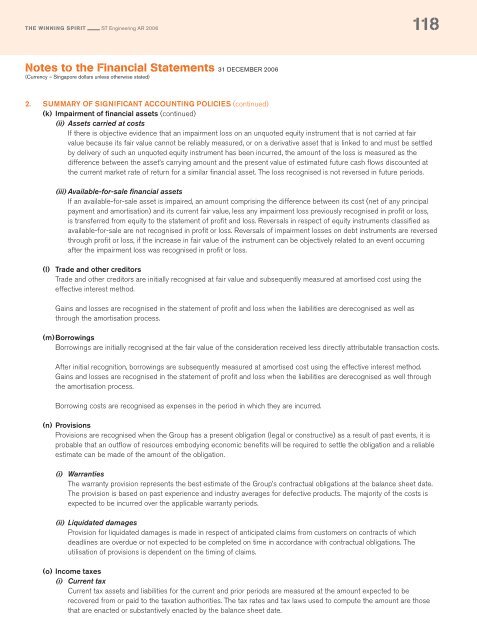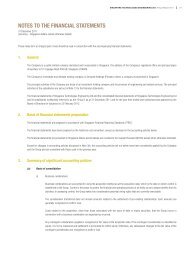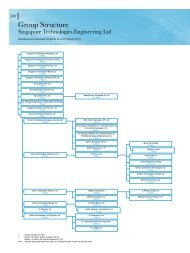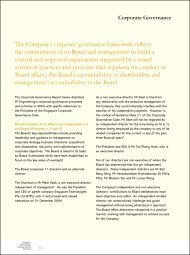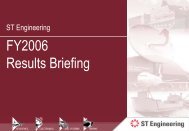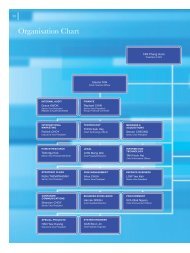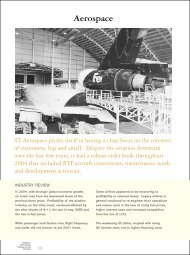Full Annual Report 2006 - Singapore Technologies Engineering
Full Annual Report 2006 - Singapore Technologies Engineering
Full Annual Report 2006 - Singapore Technologies Engineering
You also want an ePaper? Increase the reach of your titles
YUMPU automatically turns print PDFs into web optimized ePapers that Google loves.
THE WINNING SPIRIT ST <strong>Engineering</strong> AR <strong>2006</strong> 118<br />
Notes to the Financial Statements 31 DECEMBER <strong>2006</strong><br />
(Currency – <strong>Singapore</strong> dollars unless otherwise stated)<br />
2. SUMMARY OF SIGNIFICANT ACCOUNTING POLICIES (continued)<br />
(k) Impairment of financial assets (continued)<br />
(ii) Assets carried at costs<br />
If there is objective evidence that an impairment loss on an unquoted equity instrument that is not carried at fair<br />
value because its fair value cannot be reliably measured, or on a derivative asset that is linked to and must be settled<br />
by delivery of such an unquoted equity instrument has been incurred, the amount of the loss is measured as the<br />
difference between the asset’s carrying amount and the present value of estimated future cash flows discounted at<br />
the current market rate of return for a similar financial asset. The loss recognised is not reversed in future periods.<br />
(iii) Available-for-sale financial assets<br />
If an available-for-sale asset is impaired, an amount comprising the difference between its cost (net of any principal<br />
payment and amortisation) and its current fair value, less any impairment loss previously recognised in profit or loss,<br />
is transferred from equity to the statement of profit and loss. Reversals in respect of equity instruments classified as<br />
available-for-sale are not recognised in profit or loss. Reversals of impairment losses on debt instruments are reversed<br />
through profit or loss, if the increase in fair value of the instrument can be objectively related to an event occurring<br />
after the impairment loss was recognised in profit or loss.<br />
(l) Trade and other creditors<br />
Trade and other creditors are initially recognised at fair value and subsequently measured at amortised cost using the<br />
effective interest method.<br />
Gains and losses are recognised in the statement of profit and loss when the liabilities are derecognised as well as<br />
through the amortisation process.<br />
(m) Borrowings<br />
Borrowings are initially recognised at the fair value of the consideration received less directly attributable transaction costs.<br />
After initial recognition, borrowings are subsequently measured at amortised cost using the effective interest method.<br />
Gains and losses are recognised in the statement of profit and loss when the liabilities are derecognised as well through<br />
the amortisation process.<br />
Borrowing costs are recognised as expenses in the period in which they are incurred.<br />
(n) Provisions<br />
Provisions are recognised when the Group has a present obligation (legal or constructive) as a result of past events, it is<br />
probable that an outflow of resources embodying economic benefits will be required to settle the obligation and a reliable<br />
estimate can be made of the amount of the obligation.<br />
(i) Warranties<br />
The warranty provision represents the best estimate of the Group’s contractual obligations at the balance sheet date.<br />
The provision is based on past experience and industry averages for defective products. The majority of the costs is<br />
expected to be incurred over the applicable warranty periods.<br />
(ii) Liquidated damages<br />
Provision for liquidated damages is made in respect of anticipated claims from customers on contracts of which<br />
deadlines are overdue or not expected to be completed on time in accordance with contractual obligations. The<br />
utilisation of provisions is dependent on the timing of claims.<br />
(o) Income taxes<br />
(i) Current tax<br />
Current tax assets and liabilities for the current and prior periods are measured at the amount expected to be<br />
recovered from or paid to the taxation authorities. The tax rates and tax laws used to compute the amount are those<br />
that are enacted or substantively enacted by the balance sheet date.


